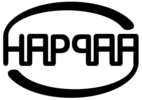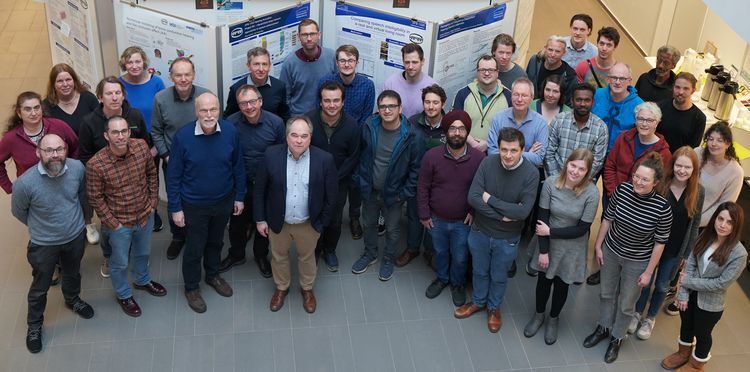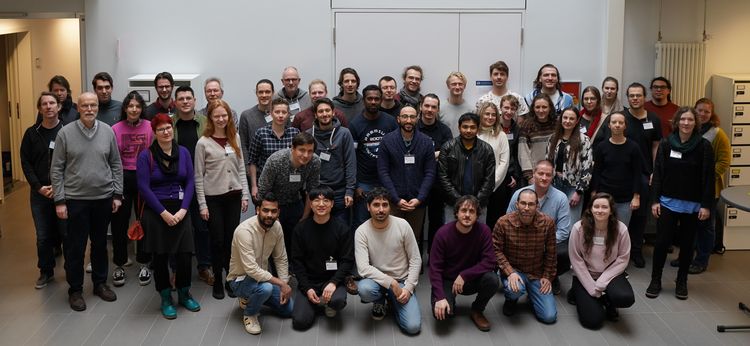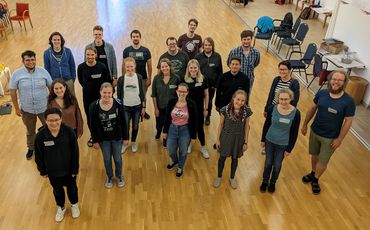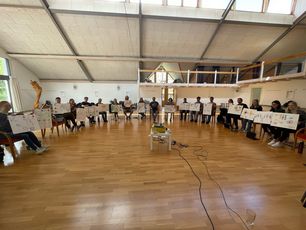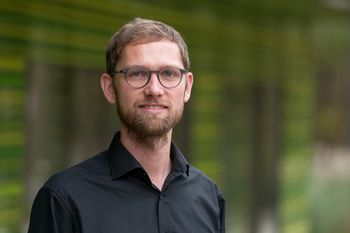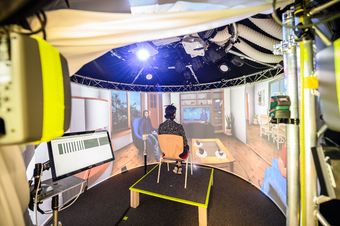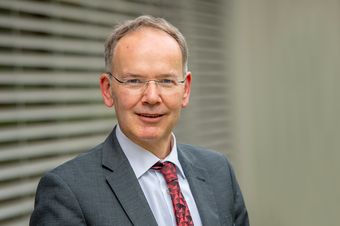In this presentation, he used a simple ellipsoid model to illustrate the influence of various parameters on the modelling of bone conduction of human heads. His research is part of the CRC 1330 HAPPAA funded by the Deutsche Forschungsgemeinschaft (DFG).
News
23./24.05.2024 Plenary meeting of the SFB in the NeSSy research building
One day after the Long Night of Hearing, the SFB HAPPAA will meet again for a plenary meeting at the University of Oldenburg. In addition to project presentations, two poster and demonstrator sessions are planned.
22.05.2024 Long Night of Hearing with SFB participation
How does hearing work? What role does the brain play? What are the causes of hearing loss? And do animals actually hear differently?
The Long Night of Hearing, which is being jointly organised by the SFB HAPPAA and five other institutions to mark the 50th anniversary of the University of Oldenburg, offers answers to these questions and much more.
A varied programme with lectures, insights into highly specialised laboratories, interactive demonstrations as well as concerts and creative contributions relating to the world of hearing will be offered at three locations. There will also be the opportunity to find out about thematically relevant STEM degree programmes and find out how you can become part of cutting-edge research as a test subject.
Further information can be found at: www.uol.de/lange-nacht-des-hoerens
16./17.11.2023 Plenary meeting of the CRC in the NeSSy research building
The second plenary meeting of the CRC in 2023 took place on 16 and 17 November 2023 in Oldenburg in the NeSSy research building. As always, the meeting focussed on project presentations and demonstrator sessions as well as two poster sessions in the NeSSy foyer.
20./21.04.2023 Plenary meeting of the SFB took place in NeSSy
The first totally on-site meeting of the SFB after Corona took place in Oldenburg at the research building NeSSy on April 20th/21st, 2023. The meeting focussed on project talks and demonstator sessions and included also two poster sessions in the NeSSy foyer. Everybody was very happy to meet in person again, especially with our members from Aachen and Munich.
13./14.03.2023 - First winter school of the CRC is a great success
The first „Winter School on Hearing Acoustics: Models, Machine Learning, Applications, and Virtual Reality” took place from 13.03.2023 – 14.03.2023 at the University of Oldenburg, Germany. It provided a great opportunity for Master and PhD students to broaden their understanding in several fields required in cutting-edge hearing research. In total, 47 students participated in sessions and hands-on exercises focussing on audio signal processing & machine learning, auditory modeling and psychoacoustics, hearing aids and audiology and virtual acoustics.
13.10.2022 Upgrade of anechoic free-field room is finished

The door of the Anoechoic Lab on Wechloy Campus opens onto a world of silence. The key feature of the recently renovated acoustics lab is its huge wedge-shaped sound absorbers.
Noises from outside cannot penetrate the walls of this room, and any sound waves inside are instantly absorbed: the "anechoic free-field chamber" at Oldenburg University is one of the quietest rooms in Oldenburg – and probably one of the quietest in all Germany. Almost 40 years after it was first built, the university’s extraordinary acoustics laboratory needed a major overhaul: each one of its wedge-shaped sound absorbers had to be replaced. The renovation was planned and carried out by the Staatliches Baumanagement Region Nord-West Region in collaboration with the architecture firm Architekt Fritsch. The university used its own funds to finance the measure.
“The anechoic chamber is a key research facility for the Hearing4all Cluster of Excellence, the Collaborative Research Centre Hearing Acoustics and many more of our research projects. In addition, non-university hearing research institutions also use the room,” stresses acoustician Prof. Dr. Steven van de Par, whose department runs the laboratory. “The renovated lab now once again offers optimal conditions and the necessary flexibility for numerous technical measurements and our tests with test persons.”
The scientists use the lab to perform extremely precise analyses of the acoustic properties of devices such as loudspeakers and microphones which are needed in certain research projects. They also use it to conduct hearing experiments with test subjects, in particular spatial hearing tests.
Acoustics like those on the top of a mountain when there’s no wind
The renovated lab is located in a separate building adjacent to the physics department on Wechloy Campus. It was built together with the main building in 1984 and is a "room-in-room” construction, with an inner room supported by metal springs and thereby isolated from the outer environment. There is also a one-metre gap between all the walls and the outer shell of the building, and the ventilation and lighting systems can be operated almost silently. All six walls, including the ceiling and floor, have been sound-proofed using the 1.5-metre-long wedges. "There are more than 2,500 wedges in total," points out Dr Stephan Töpken, who supervised the technical aspects of the renovation together with technician Christoph Scheicht.
Considerable effort was put into preventing sound reflections in the room: the new absorbers are covered with a special, non-combustible fabric which reflects hardly any sound. To facilitate the installation of experimental set-ups and measuring devices, a number of rods and hooks were attached to the floor and ceiling in between the sound absorbers. "Our lab offers controlled acoustic conditions across almost the entire hearing frequency range," Töpken emphasizes.
A special feature of the Oldenburg laboratory is that thanks to the large size of the sound absorbers even low-frequency sound waves are effectively absorbed. The sound absorption extends all the way down to a frequency of 50 hertz – a very low hum. Because sound is not reflected back from any of the three spatial directions, the acoustics are equivalent to those experienced on the top of a mountain when there is no wind. Experts refer to this as “free field” acoustics.
In addition to researchers from various departments at the University of Oldenburg, the Anechoic Lab is also used by research teams from the Jade University of Applied Sciences and the Fraunhofer Institute for Digital Media Technology IDMT.
[Text/photo: Presse release of the Universität Oldenburg (in German), 07.11.2022]
12.10.2022 Study on hearing damage among musicians
An episode from "Deutschlandfunk Kultur: Zeitfragen" deals with the results of an online study by Kai Siedenburg on the subject of hearing damage among professional musicians.
The audio and the article about it can (in German language) be found at:
Hörschäden bei Berufsmusikern – laut wie ein Presslufthammer. Sven Kochale. Deutschlandfunk Kultur, 06.10.2022
https://www.deutschlandfunkkultur.de/berufsmusiker-gehoer-schaeden-vorsorge-100.html
22.09.2022 Anna Warzybok-Oetjen receives prize of the German Society for Audiology
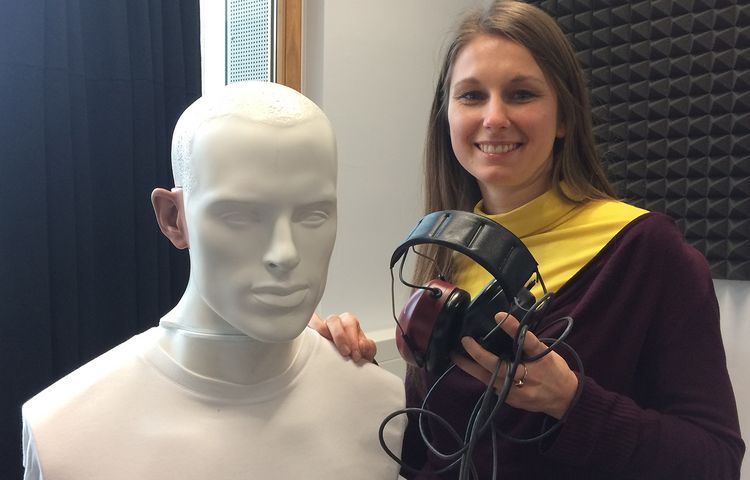
Oldenburg. The German Society for Audiology (DGA) has awarded the Meyer-zum-Gottesberge Prize to Dr. Anna Warzybok-Oetjen from the University of Oldenburg, for her work in the field of hearing research.
Warzybok-Oetjen has contributed to making matrix language tests that researchers use to measure a person's speech comprehension available in other languages. Her work is important for the transferability of test results and contributes to the internationalisation of speech audiology.
Anna Warzybok-Oetjen has already received several awards, including the Lothar Cremer Prize of the German Society for Acoustics. She now accepted the Meyer-zum-Gottesberge Prize at the DGA annual conference in Erfurt. She is the fourth prize winner from the University of Oldenburg.
Contact
Dr. Anna Warzybok-Oetjen, Tel.: 0441/798-5499, e-mail:
23.07.2022 ASA "early career presenter award" for Simon Kersten
During the 182nd Meeting of the Acoustical Society of America (ASA) in Denver, Colorado, PhD student Simon Kersten from the group of Prof. Dr. Michael Vorländer, RWTH Aachen, was honored with the Early Career Presenter Award of the Computational Acoustics Technical Committee for his presentation on the “Influence of the Model Parameters for the Finite Element Simulation of Bone Conduction in the Human Head”.
10.06.2022 PhD workshop Oberlethe
On June 8th-9th 2022, a SFB HAPPAA workshop for PhD students and early Postdocs was held at Hof Oberlethe in Wardenburg.
The workshop was organized by a team of PhD students and included a variety of scientific topics. To foster science communication in a creative manner, the participants painted pictures about their research project and wrote short abstracts about their topic in simple speech. These drawings and abstracts were later presented in a poster session and three posters were selected for a poster prize.
Furthermore, the workshop enabled the PhD students and postdocs to discuss relevant topics of their work and talk about their experiences of being a PhD student. A talk by science journalist Dr. Mai Thi Nguyen-Kim from her TV show about the working conditions and diversity in science and its impact on young researchers was also analysed and discussed.
Highlights of the workshop were two career sessions for networking with former PhD students. The invited alumni (Angela Josupeit (Oticon A/S), Angel Mario Castro Martinez (Telekom), Henning Schepker (Starkey Hearing Technologies), Dorothea Wendt (Eriksholm Research Centre), Birgitta Gabriel (freelance consultant for hearing acoustics) and Lena Schell-Majoor (postdoc at the University of Oldenburg)) presented their careers and discussed topics like the transition from university to industry, work-life balance, helpful skills and career options with the participants.
The program was rounded off by other activities such as a sign language course, yoga and a get-together with games for further networking.
08.06.2022 - Hearing scientist and CRC PI Kai Siedenburg accepted into Junge Akademie: Research at the intersection of science, art and society
The hearing scientist Dr. Kai Siedenburg has been accepted as a new member of the ”Junge Akademie”. During the next five years, the budget from the academy will allow him to better interconnect with other young researchers, by organising workshops and symposia and by publishing joint research papers.
Kai Siedenburg is one of 10 new members who are elected each year for a total duration of five years before becoming an alumnus of the academy. He is a member of the Department of Medical Physics and Acoustics at the University of Oldenburg and a new PI in the second funding period of the CRC Hearing Acoustics. His group ”Music Perception and Processing” is funded by the Freigeist Fellowship of the VolkswagenStiftung.
For more information see the official press release of the University of Oldenburg (in German only).
Weblinks
- Website of Kai Siedenburg’s group: uol.de/en/music-perception
27.05.2022 - Another success for Oldenburg's hearing research:
Collaborative Research Centre Hearing Acoustics to receive funding for another four years
Oldenburg. Smart hearing aids that adapt to the individual needs of the user: for the last four years, the researchers of the Collaborative Research Centre (CRC) Hearing Acoustics have been working towards this goal. Now the German Research Foundation (DFG) has extended the funding of the project. Led by Prof. Dr. Volker Hohmann, a hearing researcher at the University of Oldenburg, the CRC will receive up to 8.1 million euros for a second funding phase running from 2022 to 2026. With the official title “Hearing Acoustics: Perceptual Principles, Algorithms and Applications” (HAPPAA), the CRC is focusing on developing hearing aids and hearing assistance systems that use artificial intelligence (AI) to automatically adjust to different environments, making these devices more adaptable to the specific needs of individual users. In addition to the University of Oldenburg, the Jade University of Applied Sciences, the Fraunhofer Institute for Digital Media Technology IDMT, the Hörzentrum Oldenburg gGmbH, RWTH Aachen University and the Technical University of Munich – all leading institutions in the field of hearing research – are involved in this large-scale project which is scheduled to run for a total of twelve years.
"In our ageing society it is becoming increasingly urgent to develop hearing aids and other communication aids that work effectively in difficult acoustic environments and really help people in daily life. Oldenburg's hearing research is doing excellent work and is highly recognized both nationally and internationally. The German Research Foundation's renewed funding commitment underlines this in an impressive way," said University President Prof. Dr. Ralph Bruder.
The Collaborative Research Centre Hearing Acoustics brings together various disciplines, in particular acoustics, psychoacoustics, audiology, engineering sciences and physical modelling. In the first funding period the focus was on the interactions between people with impaired hearing and their acoustic environment. "In real life, the hearing situation changes constantly because people react to voices and sounds. For example, they turn their head towards the sound source, or shift their gaze in that direction. We call this the 'acoustic communication loop'," says Hohmann. This dynamic loop had received little attention in hearing acoustics in the past, he notes.
In the last few years the team has succeeded in incorporating the hearing aid into this acoustic communication loop. "We have developed a first prototype of the so-called 'immersive hearing aid' which constantly assesses the acoustic situation and identifies which sound source a test person is directing their attention towards at a given moment," Hohmann explains. The device determines the direction of the test person's gaze and head movements and then adjusts the signal processing to ensure that the targeted sound source can be optimally heard by the test person. The current prototype can be used in field experiments as well as in the lab.
Among other factors, new perception models developed by the research team for use in different hearing situations have paved the way for this success. "These models predict how a test person will perceive a sound signal in a given situation – whether or not they will be able to follow a conversation in a noisy environment, for instance," Hohmann explains. Simulating hearing with and without hearing impairment in different hearing situations involving background noise and reverberation is essential for the development and evaluation of innovative methods for signal processing in hearing aids, he stresses.
Another important result from the first funding period is the "hearpiece" – a special, particularly high-quality earpiece for research purposes. Inserted in the ear and featuring several integrated microphones and small loudspeakers, the device can boost sound in exactly the same way as a hearing aid. The researchers can use it to test new algorithms for signal processing directly in the ear, for example. The special feature here is that the hearpiece is acoustically transparent – which means that hearing with this device corresponds to normal hearing with an open ear. "Thanks to the interdisciplinary collaboration within the CRC we were able to combine acoustics and signal processing methods and have made considerable progress as a result," says Hohmann.
The team has also developed an interactive, audiovisual virtual reality set-up in the lab for conducting hearing experiments with test subjects under controlled conditions. With this technology, real-life situations can be simulated more realistically than was previously possible. To this end, the team created several complex audiovisual scenarios in which test persons can "immerse" themselves, including a virtual restaurant, an underground station and a living room. These scenarios, together with the related data, have been made freely available to research laboratories across the world so that they can conduct their own hearing experiments.
In the second funding period that will now commence, the CRC team plans to refine and merge its perception models, algorithms and applications. One goal is to develop algorithms for the hearpiece and the immersive hearing aid that can actively control noise depending on the acoustic scenario. To do this, the researchers are using cutting-edge AI methods which they themselves developed. The long-term goal is for each hearing aid to constantly learn and get better at predicting which setting is optimal for the respective user in a specific situation. People with impaired hearing are to be able to enter the necessary feedback themselves via their smartphone. "However, we still have a lot of work to do before we reach this goal," notes Hohmann.
The team is also working on establishing international standards for complex acoustic scenarios in hearing research and audiology in order to facilitate and enhance exchange between different laboratories. In addition, the CRC aims to develop new hearing-acoustic tests in virtual environments that enable researchers to better identify differences in individual perception. This should make it possible to design diagnostics and hearing aid rehabilitation measures that are optimally tailored to individual needs.
The Collaborative Research Centre complements the research conducted by the Cluster of Excellence Hearing4all, which is also led by researchers from the University of Oldenburg. In addition, it actively supports the doctoral projects of early career scientists with its own integrated Research Training Group.
[Text: Press release of the Univerity of Oldenburg], 27.05.2022
28.04.2022 - Future day for girls and boys: Experiments around hearing
The "Future Day for Girls and Boys in Lower Saxony" has existed since 2005 and is based on the concept of the nationwide "Girls' Day" and "Boys' Day". It serves to let girls and boys explore "gender-atypical" professions.
The SFB 1330 and the Department of Medical Physics and Acoustics are participating in this year's Future Day with several offerings on the topic "Experiments around hearing: From smartphone to virtual reality to the brain". The intended participants are girls and boys of the 5th/6th or 8th/9th grade.
For more information in German language see uol.de/zukunftstag
12.04.2022 - Wiebke Middelberg nominated for ARD/ZDF award "Women + Media Technology” 2022
For her master thesis "GSC-based noise and interferer reduction for binaural hearing aids exploiting external microphones", which had already been awarded the DEGA student prize, PhD student Wiebke Middelberg has been nominated for the ARD/ZDF sponsorship award "Frauen + Medientechnologie” (Women + Media Technology) in March 2022.
Wiebke Middelberg is one of ten finalists whose theses will compete for three prizes worth a total of €10,000 at the end of May. She is also the first person from the Carl von Ossietzky University Oldenburg to be nominated for this award in its fourteen-year history.
The award ceremony will take place on June 21, 2022 at 2:30 p.m. as part of the Global Media Forum at the World Conference Center Bonn.
Further information (in German):
22.03.2022 - DEGA Student Award for Wiebke Middelberg

M.Sc. Wiebke Middelberg, PhD student in the Signal Processing group of Prof. Dr. Simon Doclo, has received the student award of the German Society for Acoustics (DEGA) for her master thesis during the DAGA conference on March 22, 2022.
In her master thesis, entitled "GSC-based noise and interferer reduction for binaural hearing aids exploiting external microphones," which was written in the framework of the CRC 1330 Hearing Acoustics, Wiebke Middelberg explored different ways to improve speech intelligibility in hearing aids by using external microphones to reduce ambient noise and competing speakers.
For more information, see (in German):
03.03.2022 - Hörgeräte: Eine Herausforderung für die Forschung (in German only)
A short introduction into the work in the Gesture Lab at the Oldenburg University
NDR, Hallo Niedersachsen, broadcasted 03.03.2022, 19:30 Uhr
28.01.2022 - Face mask: lip reading is missing
Poor speech intelligibility has mainly visual reasons
Oldenburg. Hearing researchers of the University of Oldenburg have discovered that the reason it is harder for us to understand the person we are talking to when they are wearing a face mask is primarily due to the fact that we cannot look at their mouth.
Researchers from the Department of Medical Physics and Acoustics and the University Department of Otolaryngology showed in the study "How Face Masks Interfere with Speech Understanding of Normal-Hearing Individuals: Vision Makes the Difference", published in the journal Otology & Neurotology, that not only people with impaired hearing, but also a large proportion of others unconsciously benefit from lip reading in everyday life. Without lip reading, speech comprehension drops significantly.
To find out how the wearing of fabric and medical masks affects the understanding of speech, the researchers played several sentences to their subjects. In some cases, subjects only heard the sound, in others they also saw the video of the speaker. In the audiovisual condition, the speaker's mouth was often covered by a virtual mask. In addition, the test subjects heard either the original sound or one with acoustic attenuation typical for the two types of masks investigated.
In all scenarios, the researchers measured how well the participants could understand the sentences played in a situation with background noise. Despite the same sound quality, speech comprehension decreased by about one third when the speaker's mouth was hidden behind the virtual mask. Speech comprehension decreased just as much when the participants could not see the speaker at all.
Therefore, visual restrictions had a greater effect than the acoustic attenuation caused by the masks. The fabric mask worsened intelligibility slightly more than the medical mask. The team is currently carrying out measurements with FFP2 masks.
Original paper: Rasmus Sönnichsen, Gerard Llorach Tó, Sabine Hochmuth, Volker Hohmann, Andreas Radeloff: „How Face Masks Interfere with Speech Understanding of Normal-Hearing Individuals: Vision Makes the Difference“, Otology & Neurotology (2022), doi.org/10.1097/MAO.0000000000003458
Original text: Pressemittelung 017/22 der Universität Oldenburg, Bereich Forschung, 28. 01.2022



